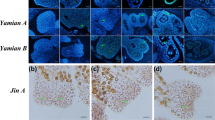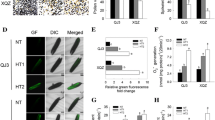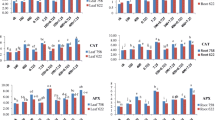Abstract
Reactive oxygen species (ROS) and malondialdehyde (MDA) in plant cell are thought to be important inducible factors of cell apoptosis if excessively accumulated in cells. To elucidate the metabolic mechanism of MDA production and scavenging in the cytoplasmic male-sterile (CMS) rice, CMS line and maintainer were employed for studying the relationship at different developmental stages by marking upmost pulvinus interval method of experiment. The results showed that the panicles and leaves of the CMS line had a noticeable higher MDA content than those of maintainer line at all five stages that had been investigated (p < 0.05). MDA content in the CMS line in the flag leaves of auricle in the distance 0 mm stage (the meiosis stage) was the highest of the five stages. The increase of MDA contents in sterile panicles and leaves had inducible effects on the enzymic activity of superoxide dismutase (SOD), catalase (CAT), and peroxidase (POD). However, at the abortion peak stage, MDA was excessively accumulated and antioxidant enzymic activity reduced significantly, resulting in the generation and scavenging of MDA out of balance.
Similar content being viewed by others

Avoid common mistakes on your manuscript.
Introduction
Cytoplasmic male sterility (CMS) is a maternally inherited trait under which a plant is unable to produce or release functional pollens, which play an important role in the utilization of hybrid vigor. CMS is associated with abnormal recombination of mitochondria1 genome; however, its mechanism is not very plain [1]. Mitochondrion provides energy for all kinds of activities in cells through respiration. Meanwhile, mitochondrion generates reaction oxygen species (ROS), which may be damaging to the organisms by the reaction of respiration chain. ROS include hydroxyl radical (.OH), and the singlet oxygen (1O2). In vivo, if ROS are not promptly cleared, the organism will suffer oxidative stress, resulting in protein and nucleic acid damage, lipid peroxidation, and even necrocytosis [2, 3]. There are enzymatic and nonenzymatic antioxidant systems in living cells, and the enzymatic antioxidant system consists of superoxide dismutase (SOD), catalase (CAT), peroxidase (POD), and other antioxidant enzymes [4]. SOD can catalyze the conversion of O2•– to H2O2 and O2. POD can decompose H2O2 to O2 and CAT can dismutate H2O2 into H2O [5]. This antioxidant system plays an important role in the H2O maintenance of cell homeostasis and antioxidant response.
Excessive accumulation of ROS was reported in the CMS anthers of rice [6, 7]. Nevertheless, the metabolism of ROS generation and scavenging, and its relationship to CMS as well, is still not clear. Therefore, we used leaves and panicles of rice CMS-451A and its maintainer line 451B as experimental materials to study the malondialdehyde (MDA) content and dynamic changes of antioxidant enzymes at different developmental stages, and to investigate the internal relations between rice CMS and MDA content.
Materials and Methods
Materials
A typical CMS line, 451A, and its fertile maintainer line, 451B, were grown in experimental fields of Xinxiang Academy of Agricultural Sciences in the 2013.
Previous studies have shown that abortive pollen sterile lines are mostly in the period of pollen mother cell proliferation and the late mononuclear meiosis period. According to the laws of the organ growth with stretch, we can use auricle distance in assessing the stages of microspore development. From this test, by each flag leaf of auricle, the distance (the auricle distance between the penultimate leaf and flag leaf, the unit is millimeter) mode to 0 was the standard of meiosis [8]. The test marked each tillers of flag leaf of auricle in the distance −20, −10, 0, 10, and 20 mm, a total of five sections. Each section represents a period of developmental stage. In each stage, the materials (three flag leaves and three panicles) were taken. Then, the materials are placed on the ice back at the lab unity to determine enzyme activity.
In the starting stage of rice with 20 paper bags of sterile lines to prevent pollination, through the artificial pollination on the 10 bagging sterile plant with male parent of 452R restorer lines; after rice matures, the statistics 451A selfing seed and the 452R artificial pollination of hybrid seed setting rate was finished.
Methods
Determination of MDA Contents
The content of MDA was measured according to Hodges et al. [9], which was noted as μg g−1 (FW).
Determination of ROS-Scavenging Enzyme Activities
SOD activity was assayed by measuring the inhibition of photochemical reduction of nitro blue tetrazolium (NBT) according to the method of Wang et al. [10]. One unit of SOD activity was defined as the amount of enzyme required to cause 50 % inhibition of the reduction of NBT. POD activity was determined according to Kochba et al. [11]. One unit of POD activity was defined as the increase of OD per minute. CAT activity was measured by the method of Jiang et al. [12]. One unit of CAT was defined as the decrease of OD per minute.
Results
Contents of MDA
The panicles of the CMS line had a higher MDA content (Fig. 1) than those of maintainer at all five stages (p < 0.05). MDA content in the CMS line in stage 3 was the highest of the five stages, at 96 % more than that of the maintainer. The MDA content in stage 1 was the lowest in the sterile line and maintainer of all the stages. MDA content rose at all stages in the maintainer line.
The leaves of the CMS line also had a higher MDA content (Fig. 2) than those of maintainer at all five stages (p < 0.05). MDA content in the CMS line in stage 3 was the highest of the five stages. MDA content was almost the same at all stages in the maintainer line.
Activities of ROS-Scavenging Enzymes in the Sterile and Fertile Panicle
There were differences in SOD, POD, and CAT activities among the panicle of the CMS and maintainer lines. SOD activities (Fig. 3) had a little change in the maintainer line. SOD activities in the CMS line in stage 3 was the highest of the five stages (p < 0.05), at 328 % more than that of the maintainer.
There were significant differences in CAT activities between the panicle of the CMS line CMS and maintainer lines at all five stages. CAT activity (Fig. 4) in the CMS line at stage 3 was significantly higher (p < 0.05). CAT activity decreased at all stages in the maintainer line.
POD activities (Fig. 5) in the panicle of the CMS line in stage 2 was the highest of the five stages, at 96 % more than that of the maintainer. POD activities rose at all stages in the maintainer line.
Activities of ROS-Scavenging Enzymes in the Sterile and Fertile Leaf
There were differences in SOD, POD, and CAT activities among the leaf of the CMS and maintainer lines. SOD activities (Fig. 6) increased continuously from the first stage to the third stage but then decreased. However, SOD activities in the CMS line were always higher than in the maintainer (p < 0.05) in all five stages (except stage 4).
There were significant differences in CAT activities between the CMS and maintainer lines at all five stages. CAT activity (Fig. 7) in the leaf of CMS line was significantly lower than that in maintainer line at stages 2 and 3 (p < 0.05). Conversely, at other stages, CAT activity in the CMS line was significantly higher than in the maintainer line (p < 0.05).
The leaf of the CMS line had noticeable lower POD activities (Fig. 8) than those of maintainer at all five stages (p < 0.05). But there were the same change trend between the CMS and maintainer lines at all five stages.
Selfing Seed Setting Rate and Hybrid Seed Setting Rate
The selfing seed setting rate of 451A was analyzed after rice mature. According to our statistics, the seed setting rate was 0 %. The statistics of 451A and 452R artificial pollination of hybrid seed setting rate was 50 %. It was proved that sterile line 451A was pollen abortive.
Discussion
Plant cytoplasmic male sterility is a genetic trait controlled by the cytoplasmic genes. The mtDNA mutation in cytoplasm was perhaps the main reason for resulting in CMS [13]. The mutation of the mitochondrial gene could induce mitochondrial dysfunction. Our predecessors conducted some research on the physiological and biochemical effects of infertility on different species. Excessive ROS accumulation in cotton CMS line resulted from low SOD activities [14]. But in pepper CMS line, it suggested to be associated with the lower cyanide-resistant respiration [15]. Another development in their experimental method was divided into four stages according to the microsporogenesis progress by checking under the microscope, i.e., (stage 1) sporogenous cell division stage, (stage 2) pollen mother cell (PMC) meiosis stage, (stage 3) uninucleate microspore stage, and (stage 4) mature pollen stage. But a panicle of pollen development was not synchronous, so this experiment adopted marking upmost pulvinus interval method to get panicles and leaves using as the experiment material.
In this article, the panicles and leaves of the CMS line had a noticeable higher MDA content than those of maintainer line at all five stages (p < 0.05). MDA content in the CMS line in the flag leaves of auricle distance in the distance 0 mm stage(the meiosis stage) was the highest of the five stages. The increase of MDA contents in sterile panicles and leaves had inducible effects on the enzymic activity of SOD, CAT, and POD. However, at the abortion peak stage, ROS were excessively accumulated and antioxidant enzymic activity reduced significantly, resulting in the generation and scavenging of ROS out of balance. The apoptosis of large quantities of male cells occurred. After the abortion of sterile panicle, MDA still had adverse effects on the panicle. The excess accumulation of MDA and significant reduction of ROS-scavenging enzymic activity coincided with the apoptosis of male cells in sterile panicles.
Rice CMS with the cytoplasm had the characteristics of earlier degeneration and thorough apoptosis of male cell in comparison with CMS in other plants, which were both advantageous for hybrid seed production.
Conclusions
This study represented that the panicle and leaf of the CMS line had a noticeable higher MDA content than those of maintainer line at all five stages (p < 0.05). MDA content in the CMS line in the flag leaf of auricle distance in the distance 0 mm stage (the meiosis stage) was the highest of the five stages. The increase of MDA contents in sterile panicles and leaves had inducible effects on the enzymic activity of SOD, CAT, and POD. However, at the abortion peak stage, MDA was excessively accumulated and antioxidant enzymic activity reduced significantly, resulting in the generation and scavenging of MDA out of balance.
References
Linke, & Bomer, J. (2005). Mitochondrion, 5, 389–402.
Foyer, C. H., & Noctor, G. (2000). New Phytologist, 146, 359–388.
Esposito, L. A., Melov, S., Panov, A., Cottrell, B. A., & Wallace, D. C. (1999). Proceedings of the National Academy of Sciences of the United States of America, 96, 4820–4825.
Rudneva, I. I. (1999). Comparative Biochemistry and Physiology. C, 112, 265–271.
Arora, A., Sairam, R. K., & Srivastava, G. C. (2002). Current Science Association, 82(10), 1227–1238.
Chen, X. F., & Liang, C. Y. (1991). Acta Phytophysiological Sinica, 17, 44–48.
Li, S. Q., Wan, C. X., Kong, J., Zhang, Z. J., Li, Y. S., & Zhu, Y. G. (2004). Functional Plant Biology, 31, 369–376.
Kerim, T., Imin, N., Weinman, J. J., & Barry, G. (2003). Proteomics, 3, 738–751.
Hodges, D. M., Delong, J. M., Forney, C. F., & Prange, R. K. (1999). Planta, 207, 604–611.
Wang, A. G., Luo, G. H., Shao, C. B., & Guo, J. Y. (1983). Acta Phytophysiological Sinica, 9, 77–84.
Kochba, J., Lave, E. S., & Spiegel-Roy, P. (1977). Plant and Cell Physiology, 18, 463–467.
Jiang, Jin, Wu, Tao, F. (1982). Shanghai Science and Technology Press, Shanghai. pp. 36–38.
Touzet, P., & Budar, F. (2004). Trends in Plant Science, 9, 568–570.
Jiang, P., Zhang, X., Zhu, Y., Zhu, W., Xie, H., & Wang, X. (2007). Plant Cell Reports, 26, 1627–1634.
Deng, M. H., Wen, J. F., Zou, X. X., He, C. Z., Liu, Z. M., & Zhou, Q. C. (2009). Journal of Yunnan Agricultural University, 24(1), 22–25.
Acknowledgments
This work was financially supported by the National Natural Science Foundation of China (No. 10505018) and the Natural Science Foundation of Henan Province of the People’s Republic of China (No. 091100110401).
Author information
Authors and Affiliations
Corresponding author
Rights and permissions
About this article
Cite this article
Li, J., Dai, X., Li, L. et al. Metabolism of Reactive Oxygen Species in Cytoplasmic Male Sterility of Rice by Marking Upmost Pulvinus Interval. Appl Biochem Biotechnol 175, 1263–1269 (2015). https://doi.org/10.1007/s12010-014-1346-8
Received:
Accepted:
Published:
Issue Date:
DOI: https://doi.org/10.1007/s12010-014-1346-8











